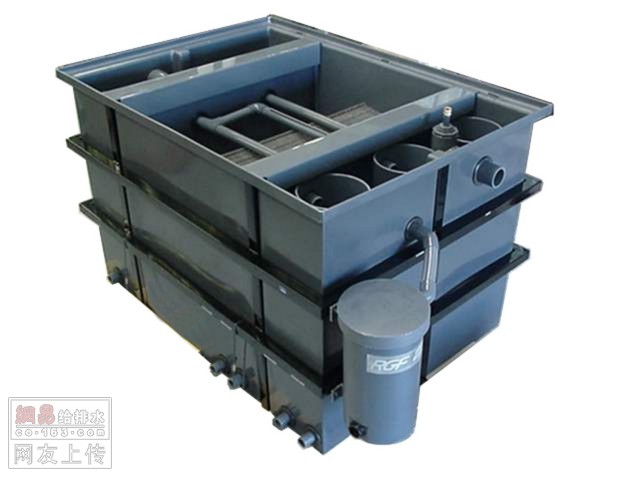 12楼
12楼
Model TPL-50 Oil Water Separator
回复
 13楼
13楼
油废水处理图片
回复
 14楼
14楼
Grease Removal System
For use in harsh conditions
Abanaki Corp.’s Grease Grabber® is a patented system designed and developed specifically to pick up heavy grease and oil quickly and easily under the harshest conditions, including freezing temperatures, fluctuating levels, and even turbulent liquids. The Grease Grabber makes use of the differences in specific gravity and surface tension between grease and water. These physical characteristics allow the belt to attract grease, oil, and other hydrocarbon liquids as the belt passes through the surface of the water. It is designed particularly for extremely demanding applications, such as scale pits, where heavy loads of grease and oil accumulate.
回复
 15楼
15楼
Oil Skimmer
Portable
Abanaki’s Tote-It® portable oil skimmer is designed to remove up to 12 gph of free-floating oil from water. The device can be hand carried from one tank to another and is suited to both indoor and outdoor applications. With proper configuration, the skimmer can handle liquids up to 212 degrees Fahrenheit with pH levels from 3 to 13. The Tote-It’s design is based on the company’s belt skimming process.
回复
 16楼
16楼
What is an Oil/Water Separator?
Oil/water separators (O/WSs) are "in-line" devices used to remove oils and greases (and sometimes solids) from industrial waste streams and storm water discharges. O/WSs operate by employing various physical or chemical separation methods, including gravity separation, filters, coagulation/flocculation, and flotation. However, the use of any separation process depends on the properties of the oil in the oil/water mixture.
The type of O/WS most frequently used by the Air Force is the gravity separation system. The performance of gravity separation systems is a function of the relatively low water solubility of petroleum products in water and their different specific gravities. (NOTE: The specific gravity of a petroleum product is defined as its density divided by the density of water. Since the density of petroleum products is less than that of water, they will float.) Solids, if present in the waste stream, will generally collect at the bottom of the O/WS holding tank and can be periodically removed when the tank is drained for maintenance.
A drain connected to an oil/water separator may be perceived as a convenient place to dispose of any type of liquid waste or sludge. This erroneous assumption can result in illegal discharges of hazardous substances to installation sewer systems (which eventually discharge to surface waters) or wastewater treatment plants. The illustration in Figure 1 shows, in simplified form, the operation of a typical gravity O/WS system.
Occasionally, simple gravity type O/WSs do not remove enough oil for the resulting wastewater to meet regulatory discharge requirements. In these cases, coalescing oil/water separators, which are essentially enhanced gravity-type O/WSs, are needed to achieve greater separation efficiency.
According to Stoke’s Law, a 100-micron diameter oil droplet will rise approximately 6 inches in water every ten minutes. A 20-micron diameter oil droplet will take over two hours to rise the same distance. Because an oil droplet must rise approximately 48 inches to reach the water surface in a typical gravity- type oil/water separator, smaller droplets may pass through uncollected. Coalescing (binding together) the smaller oil droplets makes them larger and more buoyant, causing them to rise faster. Coalescing oil/water separators may use inclined plates placed within the separation chamber, which provide only a short vertical distance (1/4") for the small droplets to travel before they encounter a fixed surface. Here they can coalesce with other droplets and continue to rise along the plates to the water’s surface. Another coalescing method uses a filter made of fine oleophillic (oil "loving") fibers such as polypropylene. The fine oil droplets attach to the fibers as the wastewater flows through. As the droplets get larger, they become buoyant enough to detach from the fibers and rise to the surface, where they can be collected.
回复
 17楼
17楼
油水分离
回复
 18楼
18楼
不错,不过全是英文,英文不太好,看的有点吃力。不知道到那为大虾能不能把它翻译过来就好了
回复
 19楼
19楼
我也支持一下
我附上效果图

回复
 20楼
20楼
谢谢楼主,长见识!
回复
 21楼
21楼
图片引我们进入实用的工作埸地,真是百闻不如一见.
gdkd
回复

